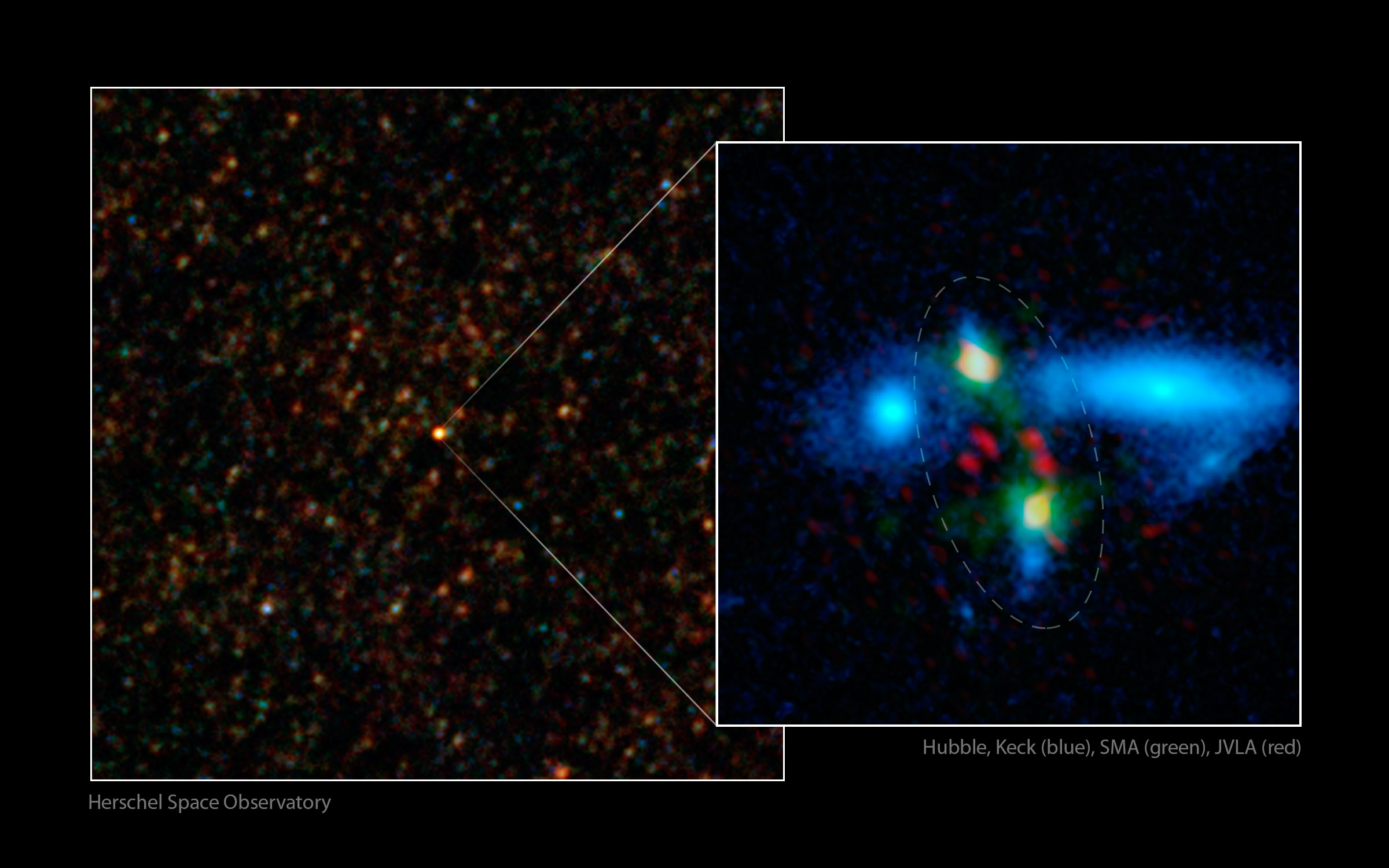News
The Mega Galaxy Merger
An international team of astronomers has spotted a massive and rare merging of two sub-millimeter galaxies (SMGs), located about 11 billion light-year away, or a time when our universe was about 3 billion years old. The duo is colliding to form a massive galaxy roughly 10 times the size of the Milky Way. Eventually, this process will lead to the formation of a super-giant elliptical galaxy, according to the research published in the journal Nature on Wednesday 22nd May.
The new galaxy, dubbed HXMM01, was first spotted as a very bright blob in images recorded by ESA's Herschel telescope, which revealed a starburst deeply embedded in dust. The research later relied on PdBI and on more than a dozen other observatories, which all together allowed to locate the galaxy couple at a redshift of 2.3, based on the detection of carbon monoxide (CO).
At first, astronomers thought the two galaxies were in fact just warped, mirror images of one galaxy. Such lensed galaxies are fairly common in astronomy and occur when the gravity from a foreground galaxy bends the light from a more distant object. After a thorough investigation, however, the team realized they were actually looking at a massive galaxy merger.
 The Making of a Giant Galaxy Several telescopes have teamed up to discover a rare and massive merging of two galaxies that took place when the universe was just 3 billion years old (its current age is about 14 billion years). The galaxies, collectively called HXMM01, are churning out the equivalent of 2,000 suns a year. By comparison, our Milky Way hatches about two to three suns a year. The total number of stars in both colliding galaxies averages out to about 400 billion suns. The Herschel Space Observatory first spotted the colliding duo in images taken with longer-wavelength infrared light, as shown in the image at left. Follow-up observations from many telescopes helped determine the extreme degree of star-formation taking place in the merger, as well as its incredible mass. The image at right shows a close-up view, with the merging galaxies circled. The red data are from the Smithsonian Astrophysical Observatory's Submillimeter Array atop Mauna Kea, Hawaii, and show dust-enshrouded regions of star formation. The green data, taken by the National Radio Astronomy Observatory's Very Large Array, near Socorro, N.M., show carbon monoxide gas in the galaxies. In addition, the blue shows starlight. The blue blobs outside of the circle are galaxies located much closer to us. These near-infrared light observations are from NASA's Hubble Space Telescope and the W.M. Keck Observatory atop Mauna Kea, Hawaii. Image credit: ESA/NASA/JPL-Caltech/UC Irvine/STScI/Keck/NRAO/SAO
|
|
"The observations with the PdBI were crucial to assess that we are looking at two colliding SMGs, separated by 18 kpc, and allowed to measure their gas reservoirs, of 100 billion solar masses each, out of which stars form", says Chiara Feruglio, co-investigator and astronomer at IRAM. Astronomers found that in these giant stellar nurseries, stars are forming at a rate of 2000 Suns per year. For comparison, the Milky Way forms about 2 to 3 Suns a year. This finding shows that massive mergers of gas-rich galaxies do in fact play a major role in the formation of the so called "red and dead" elliptical galaxies found in the distant universe. Scientists have puzzled over whether those galaxies built up slowly over time through the acquisitions of smaller galaxies, or formed more rapidly through powerful collisions between two large galaxies. "We're looking at a younger phase in the life of the red and dead ellipticals -- an adolescent burst of activity that won't last very long," said Hai Fu, lead author of the paper, post-doctoral scholar at UC Irvine.
"This discovery sheds light on a critical, short-lived transitional phase of the life of a galaxy, when it is quickly exhausting its gas reservoir, before stopping forming stars soon after", says IRAM astronomer and co-author Roberto Neri. This research shows how many telescopes working in synergy can tackle unsolved mysteries from billion years ago, and it highlights the importance of powerful millimeter interferometers. “NOEMA, the planned extension of the Plateau de Bure interferometer, will be able to further disentangle the complex interplay between the gas reservoirs in this fascinating merging system", says Roberto Neri.
|
Source : http://www.nature.com/nature/journal/vaop/ncurrent/full/nature12184.html Hai Fu et al. - Nature, May 22 2013 For further information, please contact : Chiara Feruglio and Roberto Neri - IRAM Grenoble, France Email : feruglio@iram.fr and neri@iram.fr Hai Fu - University of California, Irvine, CA 92697 USA Email : haif@uci.edu IRAM Press contact : C. Berjaud - berjaud@iram.fr NASA Public Officer : Anna Marieke - Anne-Mareike.Homfeld@esa.int |



